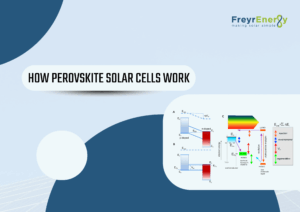Tired of using bulky, expensive silicon panels? What if solar could be lightweight, cheaper, yet with more power?
Introducing perovskite solar! It is undoubtedly the rising star of clean energy. It offered a 3% efficiency back in 2009. Today, it provides an efficiency of 26%.
Perovskite solar cells are thin, flexible and cost less. They are considered to change the future of solar technology.
Manufacturing Process of Perovskite Solar Cells
How are perovskite solar panels made? It’s a great combination of chemistry, precision and innovation that goes into creating them.
Material Preparation
The process starts with the making of perovskite ink from precursor salts. The materials commonly include methylammonium lead halide or caesium-based compounds.
The second step involves depositing a thin coat of perovskite ink on glass or plastic. It helps in getting a uniform crystal structure that absorbs sunlight efficiently.
Deposition Techniques
Deposition can be done through three primary methods:
- Wet chemical methods:
- Includes spin-coating, slot-die, roll-to-roll, and electrodeposition.
- These are cost-effective and scalable techniques for flexible modules.
- Solution deposition:
- One-step: Quick and simple
- Two-step: Better film quality and stability
- Vapour deposition:
- Ideal for tandem solar cells.
- Offers uniform layers and high throughput for industrial production.
Module Assembly
Laser scribing separates individual cells. Casing protects against moisture, UV, and oxygen. Advanced encapsulation materials are being developed to extend lifespan.
Testing & Development
Each module undergoes:
- Efficiency testing
- Durability studies
- Environmental stress simulations
Labs also explore passivation techniques. They reduce faults and improve stability.
How Perovskite Solar Cells Work

Let’s understand how these cells work.
Light Absorption & Charge Generation
Perovskite cell materials absorb sunlight across a broad spectrum. This creates electron-hole pairs with low binding energy.
That means charges separate easily, boosting efficiency.
Charge Transport
Two key layers help move charges:
- Electron Transport Layer (ETL)
- Hole Transport Layer (HTL)
Long carrier diffusion distance allows more power to be extracted.
Tandem Solar Cell
Solar panel perovskite layers can be stacked with silicon. This creates tandem cells with up to 34% efficiency.
Absorbing different wavelengths becomes easy with this. It results in collecting more sunlight.
Advantages of Perovskite Solar Panels

Let’s understand the benefits of perovskite solarzellen?
High Efficiency
Lab-tested single-junction cells reach 26% efficiency. Tandem cells go beyond 30%.
Lower Manufacturing Costs
It includes low-temperature processing and ink-based printing that reduces the overall cost. There is absolutely no need for expensive vacuum chambers or high heat.
Flexibility
Perovskite solar panels are lightweight, bendable and can be printed on plastic. They are therefore best for wearables or curved surfaces.
Defect Tolerance
Perovskite materials don’t have to undergo precision. They work well even if they aren’t manufactured with utmost perfection. This quality makes their manufacturing carefree and straightforward.
Perovskite Solar Panels Price
Currently, the perovskite solar cell price varies by size and type. Typically, the prices of small modules for IoT devices range between ₹500 and ₹1,200. Larger panels are still in pilot production.
Challenges and Limitations
Despite the promise, perovskite solar cells face hurdles.
Stability Issues
Moisture, oxygen, and UV degrade performance. Current lifespan: 2–3 years vs silicon’s 25–30 years .
Researchers are testing new encapsulation and passivation methods.
Toxicity
Most perovskite cells contain lead. This raises environmental concerns during disposal.
Solutions include:
- Lead-free perovskite materials
- Lead-absorbing layers
- Improved encapsulation
Scaling Up
Lab results are impressive. But scaling to large panels is tricky. Maintaining film uniformity and crystal quality is a challenge.
Applications of Perovskite Solar Technology
Perovskite solar panels aren’t just for rooftops.
Residential & Commercial Energy
Potentially cheaper and more efficient than silicon. Ideal for homes, offices, and solar farms.
Tandem Solar Cells
Used with silicon to maximise output. Perfect for high-performance installations.
Building-Integrated Photovoltaics (BIPV)
Transparent perovskite solarzellen can be embedded in windows and walls. They generate power without blocking light.
Space Applications
Lightweight panels reduce launch weight. NASA and ESA are exploring perovskite for satellites.
IoT & Indoor Devices
Small mini solar plate modules power sensors and low-energy gadgets. Work well under artificial light.
Hybrid Systems
Combine with batteries for smart energy storage. Useful in off-grid and backup systems.
Global Availability & Market Status
The global perovskite solar cell market is booming.
- 2024 market size: USD 264 million
- Expected to reach USD 7 billion by 2030
Leading Countries
- China: Largest producer and researcher
- Germany: Strong R&D and pilot projects
- USA: Silicon Valley startups and NASA trials
- India: IITs and private labs exploring commercial viability
Asia-Pacific holds over 50% of the global market share.
Conclusion: A New Dawn for Solar Energy
Perovskite solar panels offer speed, flexibility, and affordability. They’re not perfect yet, but soon they will be with technological advancements.
Perovskite solar cell price is falling continuously. It makes them the best choice, as solar energy companies can pass on the cost-effective benefits to their clients.
In the coming days, we will see solar panel perovskite modules powering homes, offices, gadgets and even space missions.
The future of solar is thin, bright, and perovskite-powered.
